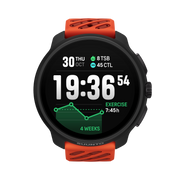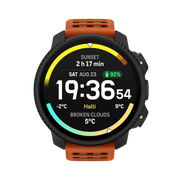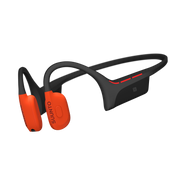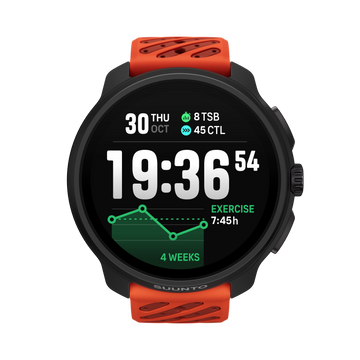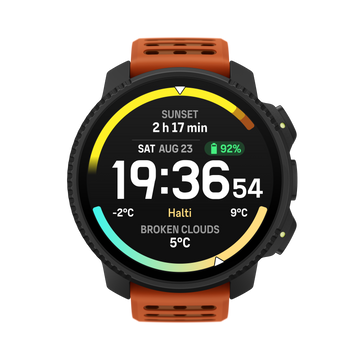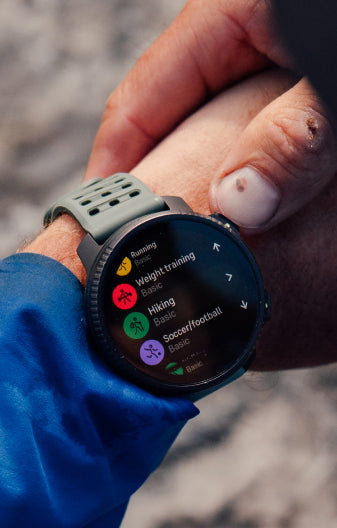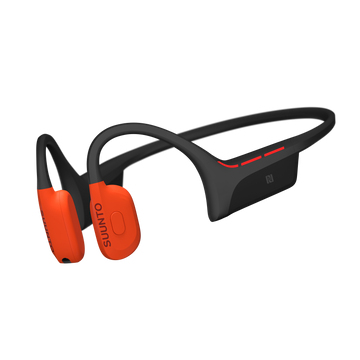

Suunto Blog

Fuelling the engine: Talking nutrition with Ultra Cycling Man
© Luigi SestiliItalian endurance cyclist Omar di Felice pushes his body through tough conditions, subzero temperatures in Norway’s icy reaches, or sweltering heat in Spain over summer. Extremes are his speciality.
This is only possible, he says, because of his careful nutrition plans. “When you keep pushing your body to the limit everyday you have to introduce the right balance in terms of calories and nutrients to get enough energy,” he says. “The first thing is to correctly balance the right quota of fat, proteins and carbohydrates”
This becomes more challenging while traveling or on a long training ride, which is why careful forward planning is so essential. Fortunately, di Felice gets supported by his girlfriend, a food blogger in Rome. She specializes in pastries, and makes di Felice plenty of cake.
© Luigi Sestili
Long distance, multi-day, rides, burn through a lot of calories quickly. That’s why di Felice follows a “fat-based nutrition” plan. “Fat is the best fuel when you are riding for hours and days, and you need lots of energy to stay focused on a long distance ride,” di Felice says. “At the same time, protein is important so you don’t burn too much muscle. And carbohydrates are important for the brain and to have quick available energies, but you need to be careful not to have too much.”
When he’s out on a long ride and doesn’t have time to stop to prepare a meal, di Felice has a few quick, go to meals, including one of his favourite foods: ice cream. Bread with ham, cheese and cake are his other regulars.
“I always try to keep in mind that, without the right energy supply, I won’t be able to do my daily training,” he says. “Nutrition is really important in my life.”
Power bar recipe: Cioccoriso
Ingredients:
300 grams dark chocolate200 grams puffed ricecoconut flakes
Method:
Put the puffed rice in a bowl with the melted chocolate and mix well. Then take a thermometer and check the temperature. Keep mixing, when it’s between 32-33°C, you can start to make the bars with a spoon on baking paper. Why not before? Because to get a good result with chocolate you have to find the right temperature, only this way the cioccoriso will be compact and will remain shiny. Leave the cioccoriso at room temperature for 40 minutes and you will see the bars reach perfection!
Recipe from: Sara De Simoni - Burro & Miele
Lead image: © Omar di Felice and © Luigi Sestili
For more articles in the Fuelling the Engine series click below:
D.I.E.T (DISASTER IMMINENT EVERY TIME ®) AND THREE UNCHANGING PRINCIPLES OF NUTRITION FOR ATHLETES.
FUELLING THE ENGINE: TALKING NUTRITION WITH EMELIE FORSBERG.
FUELLING THE ENGINE: TALKING NUTRITION WITH MELISSA HAUSCHILDT.
FUELLING THE ENGINE: TALKING NUTRITION WITH LUCY BARTHOLOMEW.
FUELLING THE ENGINE: A COMMONSENE APPROACH TO NUTRITION.

Fuelling the engine: Talking nutrition with Ryan Sandes
Avocados are a staple in Sandes’s diet. © Craig Kolesky / Red Bull Content Pool
Back home in his native South Africa, ultra runner Ryan Sandes is partial to a good braai (the South African version of a barbeque). While he generally eats whole foods most of the time, Sandes avoids getting strict or uptight about his diet. He takes a pragmatic approach.
“I believe it's important to enjoy life as well,” he says. “I don’t weigh x amount of protein, and x of carbs, I just try to eat a balanced diet with as many whole foods as possible. I try to listen to what my body is craving.”
Despite being from meat loving South Africa, Sandes and his wife Vanessa have drastically reduced their meat consumption to only once or twice a week. Instead, they focus on eating unprocessed, natural food.
“As an athlete it’s very easy to slip into taking lots of recovery shakes to try to get the goodness back into your body,” Sandes says. “But I don’t think you can replace eating good whole foods.”
Sandes ran the Great Himalayan Trail this year. © Dean Leslie / Red Bull Content Pool
In busy times
Forward planning is essential for athletes. And having a good meal plan is just as important as having a clear training plan.
Sandes often makes a big dish, with multiple portions, at the beginning of the week so he has something easy available if it’s a busy week. It’s helpful doing this, he says, because of the tendency to get a little lazy, especially later in the week.
“I often eat quite a lot of eggs, and avocados and salad, things that are easy to put together,” he says.
Sandes (and his dog) remains partial to a braai (barbecue). © Ryan Sandes
Go to meals
Sandes enjoys pizza so, when he needs an easy meal, he buys locally made pizza bases, smothers them vegetables and salad, and bakes them. Burgers, smoothies, rye bread with honey, muesli and plenty of boiled eggs are all part of his regular diet, too.
And his secret supplement is bone broth.
“These days in first world countries people eat the best cuts of meat, whereas way back in the hunter-gatherer days, if they hunted a buck they would eat the entire animal, including boiling all the bones and drinking the broth,” Sandes explains. “A lot of the good meat cuts don’t have all the essential fats, but bone broth has that. It’s not my favourite thing, but it’s great for recovery.”
The Sandes superfood grain salad recipe
Grains:
1 cup of quinoa1 cup of sorghumHalf a cup of milletHalf a cup of buckwheat
Boil all the grains separately as they all have varying cooking times.Add a can of drained and rinsed chickpeas and a can of drained and rinsed lentils.Let the grains cool down and add some lemon juice and good quality olive oil. The above amounts make quite a big bowl but you can keep it in the fridge and decant from it all week for lunch and dinner!
Other ingredients:
Chopped up avocado pearRocket and other lettuce leaves Baby spinach leavesFeta cheesePitted olivesBaby tomatoes
Salad dressing:
1/4 cup of balsamic vinegar1/2 cup of good quality cold extracted olive oil1 teaspoon of honey1 teaspoon of whole-grain or Dijon mustardOne clove of crushed fresh garlicSalt & pepper to taste
Blend all the salad dressing ingredients and lightly drizzle onto your salad. For more of an animal protein punch, add slices of grilled chicken, beef or tuna. Optional extras: drained and rinsed can of corn, chopped up fresh basil, drained and rinsed butter or cannellini beans, cut up cucumber, half a hand-full of dried cranberries.
Lead image: Photo by Jaco Pretorius on Unsplash
Read more stories about nutrition:
Fuelling the engine: A common sense approach to nutrition
Fuelling the engine: Talking nutrition with Melissa Hauschildt
Fuelling the engine: Talking nutrition with Lucy Bartholomew
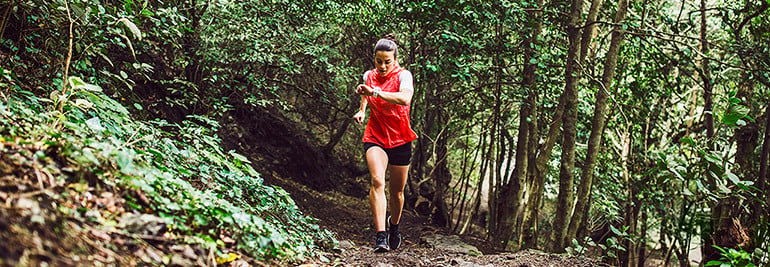
3 Things You Need to Do Before Setting Your Next Race Goal
In the 1960s, Stanford professor Walter Mischel set out to do an experiment. He tested hundreds of 4 to 5-year-olds on what turned out to be a key component to future success in work, health and life. Researchers brought each subject (a 4 or 5-year-old kid) into a private room and set a single marshmallow down on the table directly in front of them. The researcher then let the child know that they were going leave the room and if they didn’t eat the marshmallow sitting in front of them, they would get another marshmallow when the researcher came back into the room. The researcher then left the room for 15 minutes to let them decide: one marshmallow now or two marshmallows later?
DELAYED GRATIFICATION
In the past couple years you’ve probably noticed an inordinate amount of articles, podcasts, and TED Talks on the topic of happiness and life satisfaction. When people talk about being “happy,” there two different aspects to this concept.
There is happiness that we find on a daily basis through joyful activities, and then there is the happiness we find in having a greater meaning in our life that contributes to overall life satisfaction. There is feeling happiness in your life and then there’s feeling happiness about your life.
Happiness about your life sometimes includes going after bigger goals. Pushing yourself to see what you’re truly capable of. Working toward something that brings you both joy (because you enjoyed the pursuit) and satisfaction (because you had to work hard to get it). At some point when you go after a big goal you will be required to trade the immediate perceived reward right now for the bigger reward down the road. Big goals can mean big sacrifices; like not eating the marshmallow sitting in front of you.
If you’ve ever had an unfinished goal, you know how frustrating and heartbreaking it can be. You were on the path to your goal, took an unexpected side trip, and never found the road leading back to it.
What athletes don’t always know is that when they don’t accomplish a goal, they didn’t necessarily fail at the goal—they more likely failed at their goal-setting strategy. Here are three essential and research-proven goal-setting techniques for delaying gratification and holding out for the bigger reward:
HAVE A PLAN
You need to know exactly what you want and exactly how you’re going to get it. It’s worth putting in the time to formalize your goal and get specific with your strategy. The more specific you are with your vision and your plan, the more likely you are to take action on it.
WRITE IT DOWN AND SHARE IT WITH FRIENDS
Athletes who do these two things increase the probability of actually accomplishing their goals. Telling people about your goal and writing it down are added accountability factors that can increase the likelihood that you will follow through with your goals.
KNOW YOUR WHY
Why this goal and why now?
Why is this important to you?
How does this goal connect to your values and the person you want to be?
When you think to yourself “I don’t know if I can do it today” and you’re trying to find your motivation, connecting to your why can be a powerful reminder of what’s really important to you and helps you make a decision from that place. It helps you hold out for two marshmallows.
And speaking of marshmallows—you might be wondering what the kids did when the researcher left the room:
Some kids had no problem at all waiting patiently for their second marshmallow. Others immediately grabbed the marshmallow and shoved it in their mouths. And then some of the kids came up with strategies like covering their eyes and sitting on their hands to try and hold out for the bigger reward.
What’s really fascinating are the follow-up studies. Over the course of 40 years after the initial experiment, some interesting differences emerged between the children who were able to delay gratification and choose two marshmallows later versus the children who chose one marshmallow immediately.
The research from this study and subsequent studies on delayed gratification are pretty clear; the ability to delay immediate gratification is essential for success. You set goals to fulfill dreams, to move from wishing something would happen to making it happen. And when you are truly committed to your goal, there is no amount of marshmallows that will derail you. You know that the bigger reward is waiting for you down the road.
This article by Carrie Jackson Cheadle, a professor of sport psychology and expert in Mental Skills Training, was originally published on trainingpeaks.com.
TrainingPeaks provides you in-depth analysis, planning tools and coaching services to help you reach your goal. Track your workouts with your Suunto watch. Afterwards analyze your heart rate, power, pace and other data with TrainingPeaks on web or in mobile and progress towards your goals.

How to customize sport modes with Suunto app
Ultra-runner Francois D’haene wants to keep his sport modes simple.
“To be able to personalize my watch is very important for me,” Francois D’haene says.
On his trail running training sessions from home Francois likes to follow altitude, ascent and duration. For interval sessions he adds a screen with a lap table. In an ultra-race another key metric for Francois is distance.
“I don’t want to have 100 things [on my watch screen], I just want to have some important metrics.”
In ultra races duration, distance and ascent are key metrics for Francois.
Despite being first and foremost a runner, Francois also rides bikes and skis. In cycling, especially on the road, he also wants to see his speed and average speed.
When planning a sport mode for ski touring Francois highlights the importance of navigation: He includes a screen with the breadcrumb trail in his ski touring sport mode and usually plans an actual route. These add safety especially in poor weather and in white-out conditions.
LEARN HOW TO CREATE CUSTOM SPORT MODES WITH SUUNTO APP
With dozens of pre-installed sport modes Suunto multisport watches are ready to go for nearly any activity. However, should you prefer something different you can create more sport modes – and you are not limited to just one per activity type. This is useful if you want to see different metrics during a race, an interval workout and a long run, for example.
Learn how to create a sport mode on the iOS version of Suunto app
Learn how to create a sport mode on the Android version of Suunto app
GET SUUNTO APP
If you don’t use Suunto app yet, you can learn more and download it here. With the app you can customize sport modes and more on Suunto 9, Suunto 3 Fitness and Suunto Spartan watches.
KEEP YOUR SUUNTO WATCH UPDATED
For best performance, ensure that you have the latest software installed in your Suunto 9, Suunto 3 Fitness or Suunto Spartan watch: open SuuntoLink on your computer and connect your watch to your computer with its USB cable. SuuntoLink will prompt for an update if one is available.
Images © Damien Rosso / DROZ Photo

D.I.E.T (disaster imminent every time?), and three unchanging principles of nutrition for athletes
What’s the difference between eating healthy and eating right? For athlete, entrepreneur, coach and nutrition expert Dr. Rick Kattouf II this question cuts right to the heart of the debate on nutrition.
“There is a huge difference between eating healthy and eating right,” Kattouf says. “There is a huge difference between feeding the body and fuelling the body. I tell people to stop eating healthy, and they freak out.”
Rick has designed his own line of nutritional supplements. © Rick Kattouf
An example of what Kattouf calls a healthy meal is grilled chicken on a bed of greens, or a bowl of vegetables, beans with a little tofu. While Kattouf agrees these meals are healthy, he says that doesn’t make them right. Eating right is another matter.
Kattouf has credentials to back up his perspective on nutrition for athletes: during four years of pre medicine study and four years of studying optometry he learned about human physiology, pharmacology and biochemistry. The three-time age group national duathlon champion and all-round fitness freak has the performance experience to back up his approach, too.
“There’s a lot of people out there chasing one diet after the next, and one thing I am is an anti diet guy,” Kattouf says. “I trademarked the acronym for the word diet: disaster imminent every time®. That’s what a diet is. My nutrition principles haven’t changed since I was at college. And now I’m 47. Reason being is that human physiology is human physiology.”
Rick Kattouf’s unchanging principles of nutrition
Photo by Danielle Cerullo on Unsplash
When Kattouf starts coaching a new athlete he always asks the same three questions: what time of day do they get out of bed, what time of day they work out and what time do they go to bed. Being clear about this is where a proper nutrition plan begins.
“But what do most people try to focus on? Calories. It’s not about calories in and calories out. It’s all about three key principles: the proper fuelling frequency, the proper fuelling timing, and the right balance of carbohydrates, protein and fat in every meal and snack.”
Photo by Brian Erickson on Unsplash
1. The right ratio
Whether it’s a pro athlete, an age group runner or a morbidly obese person he’s coaching, Kattouf sticks to the same basic meal principle; each meal should consist of about 50 to 60 percent carbohydrates, around 15 to 25 percent protein and between 15 to 25 percent fat.
“For decades we’ve been living with this concept of a higher protein, lower carb diet,” he says. “The carbs have got the dunce hat on and have been shoved into the corner. But what is the only food that the brain can use as fuel? It’s sugars, glucose, carbs, and when we cut those out we’re going to reduce mental acuity, and not get the results we want.”
He says it’s this proper balance of “C-P-F” that plays an important role in stabilising blood sugar, reducing sharp spikes and drops, and helping the body reload. They also help to assist in repairing muscle damage, building muscle, cartilage and bone. These are “macronutrients”, meaning the body needs a large amount of them (and in the right balance) compared to micronutrients like vitamins and minerals.
“There are three things we are going to ask ourselves before every meal or snack: what is my carb, what is my protein, what is my fat. If we can answer all three of those we are moving in the right direction,” Kattouf says
2 & 3. Fuelling frequency and timing
These two are separate, but closely connected. The proper frequency is about how often to eat throughout the day. For optimal performance Kattouf says every two and a half to three hours upon the first snack at waking.
“Fuel your body immediately upon waking, not 30 minutes after, not 60 minutes after, immediately upon waking and then every two to three hours thereafter throughout the day, depending on your goals,” Kattouf says.
The proper timing is about fuelling before, during and after a workout. Having a well balanced snack immediately before a workout and one immediately after is a good start. Especially for endurance athletes, fuelling during is equally important.
Rick’s quick and easy balanced meal
2/3 cup oats1 slice whole grain bread1 TBSP peanut butter3 egg whites
Breakdown:
457 calories 52% carbohydrate23% protein25% fat
READ MORE
FUELLING THE ENGINE: A COMMONSENSE APPROACH TO NUTRITION
FUELLING THE ENGINE: TALKING NUTRITION WITH ULTRA RUNNER LUCY BARTHOLOMEW
FUELLING THE ENGINE: TALKING NUTRITION WITH TRIATHLETE MEL HAUSCHILDT
FUELLING THE ENGINE: TALKING NUTRITION WITH TRAIL RUNNER EMELIE FORSBERG
Lead photos by rawpixel and Eaters Collective on Unsplash

The data rules! A pro triathlete’s data driven training approach
Canadian triathlete Cody Beals uses his skills as a data analyst to collect, study and optimise his training. Given his recent results, the approach is paying off.
When Cody Beals became a triathlete cycling was his weakest discipline. At high school, he was a District All Star in cross country, and a good swimmer. But cycling wasn’t his thing.
The reverse is now true – cycling is his strongest discipline. And it was a data driven approach to his training that made the difference.
For proof, the 28-year-old from Guelph, Ontario won two full distance Ironmans, the first and second of his career. At his first, Ironman Mont Tremblant, he set the bike course and overall course records.
“I undertook a deliberate process of figuring out how to get my cycling up to a world class level,” Beals says. “The biggest thing was getting a power meter – it was a huge revelation! I was wasting so much time on the bike just soft pedalling. With a power meter I learned to make every minute of my riding count.”
© Welle Media
Beals has always been a data freak. He was top of his class at high school, and top of a prestigious physics programme while at university. Back then, he began capturing and analyzing data almost obsessively.
“I made my own monster spreadsheet to track every single last aspect of my life,” he says. “My sleep, my mood, my training – everything. That was when I was a self coached athlete. Even though I was making mistakes, a data approach was always something I believed in.”
After university, Beals has worked in statistics and data analysis, and is using his mastery of these skills to optimise his training. His coach, David Tilbury-Davis, shares a data based training philosophy, and the two work together on that basis. All Beals’s swim, bike and run training is measured and monitored. “The data tells the most compelling story,” he says.
Data analysis has also helped Beals in other ways. Having a Suunto 9 to capture his training runs shows Beals what’s really going on with this runs, not just what he thinks – two very different things. Perceived exertion doesn’t necessarily equate to good performance.
“I've learned through data that how you feel about something sometimes bares no relation to how you're actually performing,” Beals explains. “How I'm feeling is another data point, but it's not the most important. In the absence of power, pace or heart rate data you're just left guessing. The coach can provide part of the reality check, the rest of the reality check comes from these devices and the data they collect.”
© Welle Media
While how he feels about a workout isn’t the most important factor, conversely it is a potentially telling data point. Feeling over the moon isn’t necessarily a good sign, while feeling average isn’t always a bad one.
“I like that the Suunto 9 will prompt you for how you're feeling after each workout, he says. “That's something I have started monitoring more closely. What I've learned is that in a lot of my best training blocks, with almost every single workout, I will feel very medium.
“People assume if you're crushing it leading up to an Ironman, you're feeling great about every session, or maybe some people would assume you are so tired and fatigued that every session is brutally hard.
“The reality is that when I'm putting in my best training blocks, I'm just very stable. Everyday is pretty unremarkable. I'm not putting up epic training sessions. My mood isn't swinging around wildly. It's just day in day out consistency.”
This and other insights help Beals and his coach from avoiding overtraining syndrome, which Beals says is too often a badge of honour in the world of triathalon.
“It's kind of celebrated when athletes can push themselves to extreme lengths in training, but I will tell you that any moron can overtrain themselves,” Beals says. “The hard part is the deliberate, methodical application of training load and on the flip side recovery to reach your true potential.”
Lead image: © Ventum
READ MORE:
SLAYING HIS DEMONS: A PRO TRIATHLETE’S JOURNEY TO FINDING BALANCE
